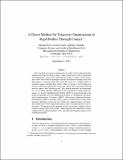| dc.contributor.author | Posa, Michael Antonio | |
| dc.contributor.author | Cantu, Cecilia | |
| dc.contributor.author | Tedrake, Russell Louis | |
| dc.date.accessioned | 2014-10-14T13:36:00Z | |
| dc.date.available | 2014-10-14T13:36:00Z | |
| dc.date.issued | 2013-10 | |
| dc.identifier.issn | 0278-3649 | |
| dc.identifier.issn | 1741-3176 | |
| dc.identifier.uri | http://hdl.handle.net/1721.1/90907 | |
| dc.description.abstract | Direct methods for trajectory optimization are widely used for planning locally optimal trajectories of robotic systems. Many critical tasks, such as locomotion and manipulation, often involve impacting the ground or objects in the environment. Most state-of-the-art techniques treat the discontinuous dynamics that result from impacts as discrete modes and restrict the search for a complete path to a specified sequence through these modes. Here we present a novel method for trajectory planning of rigid-body systems that contact their environment through inelastic impacts and Coulomb friction. This method eliminates the requirement for a priori mode ordering. Motivated by the formulation of multi-contact dynamics as a Linear Complementarity Problem for forward simulation, the proposed algorithm poses the optimization problem as a Mathematical Program with Complementarity Constraints. We leverage Sequential Quadratic Programming to naturally resolve contact constraint forces while simultaneously optimizing a trajectory that satisfies the complementarity constraints. The method scales well to high-dimensional systems with large numbers of possible modes. We demonstrate the approach on four increasingly complex systems: rotating a pinned object with a finger, simple grasping and manipulation, planar walking with the Spring Flamingo robot, and high-speed bipedal running on the FastRunner platform. | en_US |
| dc.description.sponsorship | United States. Defense Advanced Research Projects Agency. Maximum Mobility and Manipulation Program (Grant W91CRB-11-1-0001) | en_US |
| dc.description.sponsorship | National Science Foundation (U.S.) (Grant IIS-0746194) | en_US |
| dc.description.sponsorship | National Science Foundation (U.S.) (Grant IIS-1161909) | en_US |
| dc.description.sponsorship | National Science Foundation (U.S.) (Grant IIS-0915148) | en_US |
| dc.language.iso | en_US | |
| dc.publisher | Sage Publications | en_US |
| dc.relation.isversionof | http://dx.doi.org/10.1177/0278364913506757 | en_US |
| dc.rights | Creative Commons Attribution-Noncommercial-Share Alike | en_US |
| dc.rights.uri | http://creativecommons.org/licenses/by-nc-sa/4.0/ | en_US |
| dc.source | MIT web domain | en_US |
| dc.title | A direct method for trajectory optimization of rigid bodies through contact | en_US |
| dc.type | Article | en_US |
| dc.identifier.citation | Posa, M., C. Cantu, and R. Tedrake. “A Direct Method for Trajectory Optimization of Rigid Bodies through Contact.” The International Journal of Robotics Research 33, no. 1 (October 21, 2013): 69–81. | en_US |
| dc.contributor.department | Massachusetts Institute of Technology. Computer Science and Artificial Intelligence Laboratory | en_US |
| dc.contributor.department | Massachusetts Institute of Technology. Department of Electrical Engineering and Computer Science | en_US |
| dc.contributor.mitauthor | Posa, Michael Antonio | en_US |
| dc.contributor.mitauthor | Cantu, Cecilia | en_US |
| dc.contributor.mitauthor | Tedrake, Russell Louis | en_US |
| dc.relation.journal | The International Journal of Robotics Research | en_US |
| dc.eprint.version | Original manuscript | en_US |
| dc.type.uri | http://purl.org/eprint/type/JournalArticle | en_US |
| eprint.status | http://purl.org/eprint/status/NonPeerReviewed | en_US |
| dspace.orderedauthors | Posa, M.; Cantu, C.; Tedrake, R. | en_US |
| dc.identifier.orcid | https://orcid.org/0000-0003-0599-385X | |
| dc.identifier.orcid | https://orcid.org/0000-0002-8712-7092 | |
| mit.license | OPEN_ACCESS_POLICY | en_US |
| mit.metadata.status | Complete | |
